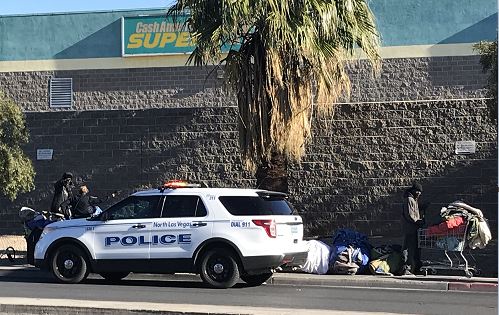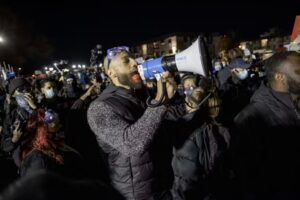1:09
News Story
Send them away, sweep them away… A look at local policy on homelessness
Las Vegas officials claim that “by offering a one-stop shop with access to medical, housing and employment services through a variety of partners” at the city’s Courtyard Homeless Resource Center, “the cycle of homelessness can be broken.”
However, the most used service at the Courtyard isn’t providing medical care, a home or a job, according to a Courtyard status report provided to the City Council in March. It’s a bus ticket to somewhere else.
In 2017 the Courtyard’s “pop up services” tried to help 70 people find work, and 101 people find housing. The effort also helped 128 people retrieve documents, and steered 536 people toward medical and mental health treatment.
And the Courtyard provided 1,160 people with “Ticket to Home” service – a bus ticket out of town.
The program doesn’t just load someone on the bus and ship them off, said Las Vegas Community Services Manager Kathi Thomas-Gibson.
“We call and make sure they have a place to go,” she said. “For many of them, this is reconnecting them with family and a support system.”
Thomas-Gibson said in the process of connecting people to other resources, the city and service providers do research on the front end to determine if leaving the city is a viable option.
Busing homeless people out of town is common practice in cities nationwide. An investigation published by the Guardian last year tracked more than 20,000 relocations of homeless people within the U.S. over a six-year period, and attempted to assess the consequences. The upshot: Sending people back to family members can be a positive step in many instances. But often as not, people who are shipped away just end up back on the street in a few weeks – except in another town. And the overall effectiveness of busing people out of one city is nearly impossible to assess. The 16 cities the Guardian examined generally conducted no long-term follow up to find what happened to the people they bused away.
Make it 17. Las Vegas doesn’t follow up once a person makes it to their destination, either.
The city has designated $50,000 out of its general fund toward providing tickets. However, Thomas-Gibson said it went over-budget by about $40,000 last fiscal year.
Las Vegas has one of the highest homelessness rates in the country, according to the U.S. Housing and Urban Development 2017 Annual Homeless Assessment Report.
The Southern Nevada Homeless Census reported 6,490 homeless individuals in the most recently released “Point in Time” count. An estimated 25,000 people were homeless in Clark County in 2017 altogether.
About 68 percent of the homeless population goes unsheltered as emergency shelters are 96 percent utilized, according to the Nevada Homeless Alliance.
Plans call for the Courtyard to eventually to provide mats for about 150 people per night to sleep in the open air.
Move along, move along, to…?
Before any homeless people are bused out of Las Vegas, they very likely have been swept around within it. Periodically rousting the homeless and forcing them to move along is a long-time staple of Southern Nevada policy for dealing with homelessness.
At least twice a week during early morning hours, the City of Las Vegas, homeless services providers and law enforcement coordinate homeless sweeps so the city can wash and disinfect the sidewalks of what city officials have branded the “Corridor of Hope” along Foremaster Lane and Owens Avenue.
“These encampments don’t have restrooms and the area needs to be cleaned,” said Thomas-Gibson with the city. “There are signs posted notifying people (these cleanings) will happen.”
Johnny Guerreo and Rick (who declined to give his last name) have both been sleeping on Foremaster Lane for about a year and are far too familiar with the ritual.
“They seem to think this is a game to see how fast we can gather our things,” Rick said. “We’ve just been dealt a bad hand (in life), but they treat us like animals.”
But the two of them, like many others on the street, comply with the requests and leave the sidewalk outside of Catholic Charities of Southern Nevada.
Later that night when the beds are filled up and all other places the homeless can go are shut down, they all come right back to where they started their day.
And the cycle repeats.
When Metro does come around, sometimes people will cross Owens Avenue to enter the City of North Las Vegas, which is outside of their jurisdiction.
“Then when North Las Vegas (police department) gets wind, we cross back over,” Grisham said.
“They are quite literally throwing away people’s lives.”
Sleeping on the street, blocking a sidewalk and unlawful camping are considered crimes.
About a year ago, the city created the Multiagency Outreach Resource Engagement (MORE) unit, a team comprised of service providers and law enforcement, to patrol the city and connect homeless people with services. So far the team has issued 52 citations and made 18 arrests, though not all of them in the homeless corridor.
Thomas-Gibson said enforcement is usually not associated with minor infractions such as sleeping on the street.
“If we were criminalizing homelessness we would see that reflected in a higher number of arrests and citations,” she said.
Nevada Current has repeatedly asked Metro for data about arrests and citations along Foremaster Lane and Owens Avenue. Metro’s Office of Public Information has thus far refused to provide that public information.
Meanwhile, a citation is far from the only fear worrying homeless people, especially during sweeps.
“I’ve seen them throw away your stuff,” Guerreo said.
Shannon Grisham, who said he lives off and on the streets periodically, contends that while rousting people from a homeless desert encampment near Owens, law enforcement treated possessions like trash. Grisham said not only did he lose court paperwork pertaining to an old custody hearing. “They tossed family photos,” he said.
Guerreo and Rick said they’ve also had items tossed by police while clearing an encampment. “Our tents, paperwork. Everything was gone.”
Any property seizures could prove troublesome for local governments in Southern Nevada. From Los Angeles to Washington D.C., lawsuits have been filed over illegal seizure of homeless people’s property. In some of those suits, judges have issued injunctions against seizing the property. And in at least a few instances, courts have awarded damages to homeless people.
“The Fourth Amendment restricts the seizure of property without compensation,” said Eric Tars, an attorney with the National Law Center on Homelessness and Poverty.
The city has said that people move their own belongings and only trash is taken.
“The city does try to respect people’s property rights,” she said. “People will always have concerns and criticism. I’m not concerned because I know we aren’t mishandling anything.”
However, the American Civil Liberties Union of Nevada said it has talked with people on the streets and even witnessed items being dumped during early morning sweeps. Amy Rose, the legal director of the organization, said that in the process people have lost identification, birth certificates and even military paperwork along with clothes and personal possessions.
“What the city is doing is pretty egregious” Rose said. “They are quite literally throwing away people’s lives.”
Even if there are signs posted along the street to indicate morning cleanings will happen, she added that doesn’t give the city the right to toss people’s belongings.
Rose said the organization is currently reviewing records to determine the best course of action.
“A little too conceptual” for the private sector
The Courtyard, modeled after a similar program in San Antonio called Haven for Hope, is currently the most publicly promoted initiative to address homelessness in Southern Nevada.
In addition to 150 mats for people to sleep in open air, plans also call for shower and laundry facilities, and replacing “porta potties” with plumbed toilets.
Unlike the San Antonio model, which is funded 40 percent from the local governments and 60 percent from the private sector, the Courtyard’s current budget is funded entirely from the city through a community development block grant, money from the redevelopment agency and the general fund.
Thomas-Gibson said she’s optimistic that in time, the private sector will provide financial support. “I think the idea was a little too conceptual and people needed to see something there.”
For some on the streets, the Courtyard is a good place. “I call it the watering hole,” Grisham said. “That place is actually a godsend. It’s nice to have a place to go during the day.”
For others, it might be a haven following the morning sweep.
And for others still, the Courtyard will be where people get on the receiving end of the most utilized homeless policy: a bus ticket to some other town.
Our stories may be republished online or in print under Creative Commons license CC BY-NC-ND 4.0. We ask that you edit only for style or to shorten, provide proper attribution and link to our website. AP and Getty images may not be republished. Please see our republishing guidelines for use of any other photos and graphics.




